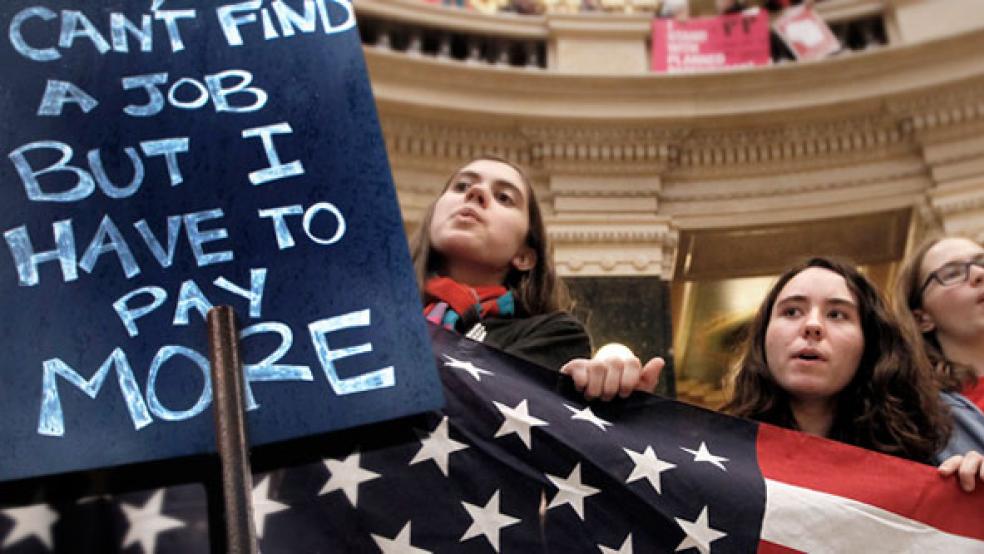With overall college loan debt now surpassing $1 trillion and telltale signs of a new emerging debt bubble, it was only a matter of time before advocates for college students and their families pushed for a change in the federal bankruptcy law to once again allow those swamped by debt to turn to bankruptcy court for relief.

The nation’s bankruptcy lawyers recently reported a sharp increase in the number of clients seeking relief from student loans. And just last week, the new federal Consumer Financial Protection Bureau said that Congress should consider allowing the hardest-pressed borrowers who are unable to keep up with their payments over a four to five year period to discharge their private student loans through bankruptcy.
RELATED: Colleges Pay Students to Graduate Faster
“Many private student loan borrowers entering the labor market in the wake of the recent recession have faced significant challenges, and many have defaulted on their private student loans,” the report stated. “Bankruptcy discharge may be an essential protection against consumer injury that might otherwise result when a consumer lacks the income or other means to manage debt. However, that benefit generally does not apply to student loans. These loans are virtually immune from discharge in bankruptcy.”
But this push to alter legislation that currently limits the ability of borrowers to turn to the bankruptcy courts for relief on student loans has run into strong conservative opposition on Capitol Hill – and received a decidedly cool reception Tuesday during a Senate Banking subcommittee hearing on the problems within the private student loan industry.
Student loans differ from most other types of loans in that they generally have lower interest rates and often don't even require credit checks or collateral. Government backed Stafford loans are based on financial need -- either for people from low income families or higher income people attending expensive schools. They provide a variety of deferment options and extended repayment terms that you could never get with a conventional loan or even a private student loan.
Private student loans are more like typical commercial loans, with higher interest rates and tougher repayment terms and penalties. They are intended to supplement federal student loans, not replace them; for many students, federal loans aren't enough, and in this case, private loans can be a good final source of funding.
For all borrowers, the average debt in 2011 was $23,300, with 10 percent owing more than $54,000 and 3 percent more than $100,000, the Federal Reserve Bank of New York reports. Average debt for bachelor degree graduates who took out loans ranges from under $10,000 at elite schools like Princeton and Williams College, which have plenty of wealthy students and enormous endowments, to nearly $50,000 at some private colleges with less affluent students and less financial aid.
‘DAMAGING’ FOR CONSUMERS
Following a surge in former students declaring bankruptcy, Congress acted to protect lenders beginning in 1977. At first, the law limited the ability of borrowers with government loans to use bankruptcy as a way out, and later the ban was changed to apply to all student loans, including those from private institutions and the federal government. The proposal outlined by the Consumer Financial Protection Bureau last week would extend bankruptcy protection only to the 7 percent of college loans provide by Sally Mae and other private financial institutions. Holders of federal loans could not file for bankruptcy.
Sen. Bob Corker, R-Tenn., the ranking member of the subcommittee, blasted the proposal, saying that seeking bankruptcy protection from student loan debt is “one of the most damaging things that a consumer can possibly do,” and would create a hardship for private lenders.
Moreover, the bankruptcy proposal has rekindled conservatives’ strong opposition and resentment towards the CFPB, which was created as part of the Dodd-Frank financial overhaul legislation and initially headed by Harvard professor Elizabeth Warren who left to run for the Senate in Massachusetts.
“I just find it fascinating that one of the first things that you would do as a consumer protection agency” is propose allowing private borrowers to seek bankruptcy protection, Corker told Rohit Chopra, the financial protection bureau’s student loan ombudsman, who also appeared before the subcommittee. “I think you can see now why so many of us thought it was a really terrible idea to have a consumer agency separate from the financial regulators.”
Sen. Sherrod Brown of Ohio, the chairman of the banking subcommittee and one of the most liberal members of the Senate, did nothing to back the bankruptcy proposal during more than two hours of hearings – and later spoke in lukewarm terms about it. “I think it’s something to look at,” he told The Fiscal Times. “I think it was a mistake that student loans were discharged differently from everything else [in the 1977 bankruptcy law] – that was carved out.”
“I don’t know that there’s much sentiment here” for legislation to once again allow private college loan holders to seek bankruptcy protection, Brown said. But he voiced concern for young college graduates saddled with huge debt “that just dogs you your whole life, no matter how responsible you try to be.”
RELATED: Bankrupt at 21: Trapped in a Web of Student Loans
As for Corker’s blast at the financial protection bureau, Brown said, “Well, I think it’s more conservatives here [who] want to defend the financial institutions – the big banks, the Wall Street banks – at all cost. They always do.”
Jack Remondi, president and chief operating officer of Sallie Mae, testified yesterday that his organization supports “reasonable reform to bankruptcy laws that would allow borrowers to discharge their education loans – both private and federal – after a good faith period of attempting to repay.”
Many of the college students and graduates who financed their education in part or in whole with private loans that carry much higher interest rates, fees and penalties than government loans view themselves as the stepchildren of the college loan system. While President Obama and Congress claimed kudos for recently enacting legislation that blocked a scheduled doubling of interest rates on college loans, from 3.4 percent to 6.8 percent, that only applied to the Stafford government loans.
The private student loan market, while small, is an important source of funding that helps students and families fill the gap between their own income and savings, financial aid, grants, federal loans and the total cost of their college or university education. Variable interest rates on private loans can range from 5 percent to 18 percent, with no limits on origination fees and other penalties.
“Borrowers have encountered an array of difficulties amidst this marketplace, including unfair lending practices, inability to manage high payments in a tough economy, and consistent issues with customer service in dealing with the lenders,” said Jennifer Mishory, deputy director of Young Invincibles, a non-profit group representing the interests of 18-to-34-year olds.
Sherrod Brown described private student loans as “the riskiest way to pay for college” and said that “unlike federal student loans, [they] are less likely to come with affordable payment plans, loan forgiveness, deferment options or cancellation rights.” About 2.9 million students have private loans, owing approximately $150 billion in debt.
According to a report released by the Federal Reserve Bank of New York, the average student loan debt burden for borrowers under age 30 has risen 56 percent since 2005 . Meanwhile, borrowers in their 40s are the most likely to default. And the parents and grandparents who may have cosigned for a child or grandchild must share the burden of younger generations.





